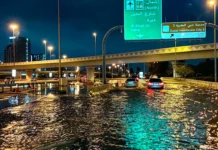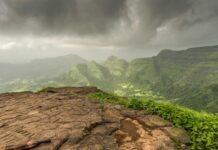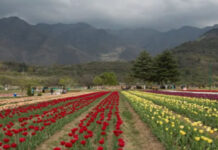Sprawling region glistens like a colorful carpet
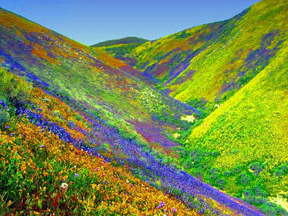 A sprawling expanse of 87 square kilometers in the Chamoli District of Uttarakhand, Valley of Flowers is set in the backdrop of the majestic Zanskar Ranges. This virtual paradise on earth was unknown to the outside world till the great Mountaineer Frank S Smith discovered it in the year 1931.
A sprawling expanse of 87 square kilometers in the Chamoli District of Uttarakhand, Valley of Flowers is set in the backdrop of the majestic Zanskar Ranges. This virtual paradise on earth was unknown to the outside world till the great Mountaineer Frank S Smith discovered it in the year 1931.
Bhyundar Valley, as the locals named it, the Valley of Flowers bears a close association with monkey god Hanuman. It is believed that it was from here that Hanuman brought Sanjivani to the ailing Lakshman. The presence of rare and exotic varieties of medicinal herbs in the valley upholds this legendary belief.
A world heritage site, the valley is situated at a very remarkable area, which is the conversion point of Himalayan ranges, Zanskar and Western and Eastern Himalayas. This fairyland located in the high altitudes of Himalayas is protected by snowy mountains. Bounded by the magnificent mountain ranges and glittering glaciers, this place unfolds the charisma and charm of nature at its best.
Unspoiled by human invasions this imposing land lay iced up in the colder months, and burst into its majestic boom on the arrival of hotter months. During these months the valley sheds its somnolent nature with its multitudes of exotic flora. When the monsoon clouds began to drizzle, the valley shows its flowery face and the entire region would glisten like a colorful carpet.
A scenic place where the nature blooms with its entire vista can be accessible by a tedious but lovely stroll. Eye catching spectacles like the cascading waterfalls, small streams and above all the flowery meadows await the visitors all through the way. With the flamboyant paddocks, crystalline streams and majestic peaks, this baroque of flowers is a worthy watch spectacle.
Tourist Attractions
 Nanda Devi National Park: Stretched over a large expanse, Nanda Devi National Park is a natural habitat to bizarre and scarce species. Beautifully placed in the midst of snowy mountain ranges of the Himalayas, this National Park proffers the lovely companionship of animal kingdom and Mother Nature. A lovely place that has been a dream destination of nature lovers and mountaineers, Nanda Devi National Park is suitably complimented by the tender countryside of the Valley of Flowers.
Nanda Devi National Park: Stretched over a large expanse, Nanda Devi National Park is a natural habitat to bizarre and scarce species. Beautifully placed in the midst of snowy mountain ranges of the Himalayas, this National Park proffers the lovely companionship of animal kingdom and Mother Nature. A lovely place that has been a dream destination of nature lovers and mountaineers, Nanda Devi National Park is suitably complimented by the tender countryside of the Valley of Flowers.
The park boasts of rich bio-diversity with so many exotic varieties of Himalayan plants and endangered animals. Rare species like the snow leopard, Asiatic black bear, blue sheep and brown bear are on the verge of extinction and the park gives them a natural environ to inhabit.
This park is gorgeous with the awesome paddocks of alpine orchards and majestic scenery. Its large variety of flora include many high value medicinal plants apart from the other extinct flora. Besides this, the park comes within the ambiance of the Western Himalayas Endemic Bird Area where some of the endangered bird species are spotted.
Nanda Devi National Park is a part of the Himalaya Biographical Zone and it has got the acclamation of national park in the year 1982.
Hemkund Sahib: A unique pilgrim centre where the Hindus and the Sikhs go hand in hand. Hemkund Sahib boasts of a rich tradition of religious tolerance. Placed at an altitude of 4329 meters, the Hemkund Lake houses Lakshman temple and a Sikh Gurudwara. It is believed that Guru Gobind Singh and Lakshman meditated on the banks of this majestic river.
A sacred pilgrim centre where people from all faiths come and pay their reverence, Lokpal or Hemkund reflects a harmonious coexistence of varied faiths. Enclosed by seven snowy mountains and their allied glaciers, Hemkund Lake replicates its surrounding beguilingly on its sparkling waters. A serene atmosphere and the enchanting scenery are sure to give a soothing effect to all those who visit the sacred premises of this holy place.
Trekking: The trek towards the Valley begins at Govind Ghat. The crisscross mule trail uncurls all the way through valleys of lovely fields and shrubbery. After three kilometers of trek, there is a tiny locale by name Pulna from where the ramble becomes much enticing with the views of glittering snowy peaks, gushing cascade and marvelous streams. The entire field looks as if painted with delicate colors. One can get some refreshments from the teashops on the wayside.
In between the flowery meadows, majestic Laxman Ganga rolls down and unites with Alaknanda. Trek through the left bank of Lakshman Ganga needs strengthening since trekking paths become sharper and stiffer. After two kilometers of tiresome trek, the trekkers reach the base camp, Ghanghria.
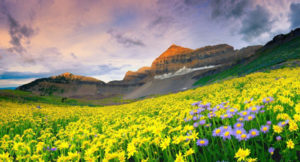 Trekking the Valley of Flowers uncurls the pictorial beauty of nature and trekkers are expected to keep up the serenity of the surroundings.
Trekking the Valley of Flowers uncurls the pictorial beauty of nature and trekkers are expected to keep up the serenity of the surroundings.
Best Season to visit Valley of Flowers is between July and October.
Valley of flowers has a cool but pleasant climate all through the year.
How to reach
By Train: The nearest railhead is at Rishikesh, 213 km. Dehradun and Haridwar railheads can be accessed, which are about 320 km
By Air: The nearest airport is Jolly Grant Airport in Dehradun, which is about 319 km from Valley of Flowers National Park.
By Bus: Joshimath is the nearest town at a distance of 17 km from Valley of Flowers. From Joshimath the distance has to be trekked. Bus services are available to Joshimath from Dehradun and Rishikesh.

